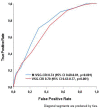Enhancing predictive accuracy of the cardiac risk score in open abdominal aortic surgery: the role of left ventricular wall motion abnormalities
- PMID: 38107265
- PMCID: PMC10722257
- DOI: 10.3389/fcvm.2023.1239153
Enhancing predictive accuracy of the cardiac risk score in open abdominal aortic surgery: the role of left ventricular wall motion abnormalities
Abstract
Background: Open abdominal aortic surgery carries many potential complications, with cardiac adverse events being the most significant concern. The Vascular Study Group Cardiac Risk Index (VSG-CRI) is a commonly used tool for predicting severe cardiac complications and guiding clinical decision-making. However, despite the potential prognostic significance of left ventricular wall motion abnormalities (LVWMAs) and reduced LV ejection fraction (LVEF) for adverse outcomes, the VSG-CRI model has not accounted for them. Hence, the main objective of this study was to analyze the added value of LV wall motion on the discriminatory power of the modified VSG-CRI in predicting major postoperative cardiac complications.
Methods: A prospective study was conducted involving 271 patients who underwent elective abdominal aortic surgery between 2019 and 2021. VSG-CRI scores were calculated, and preoperative transthoracic echocardiography was conducted for all patients. Subsequently, a modified version of the VSG-CRI, accounting for reduced LVEF and LVWMAs, was developed and incorporated into the dataset. The postoperative incidence of the composite endpoint of major adverse cardiac events (MACEs), including myocardial infarction, clinically relevant arrhythmias treated with medicaments or by cardioversion, or congestive heart failure, was assessed at discharge from the index hospitalization, with adjudicators blinded to events. The predictive accuracy of both the original and modified VSG-CRI was assessed using C-Statistics.
Results: In total, 61 patients (22.5%) experienced MACEs. Among these patients, a significantly higher proportion had preoperative LVWMAs compared to those without (62.3% vs. 32.9%, p < 0.001). Multivariable regression analysis revealed the VSG-CRI [odds ratio (OR) 1.46, 95% confidence interval (CI) 1.21-1.77; p < 0.001] and LVWMA (OR 2.76; 95% CI 1.46-5.23; p = 0.002) as independent predictors of MACEs. Additionally, the modified VSG-CRI model demonstrated superior predictability compared to the baseline VSG-CRI model, suggesting an improved predictive performance for anticipating MACEs following abdominal aortic surgery [area under the curve (AUC) 0.74; 95% CI 0.68-0.81 vs. AUC 0.70; 95% CI 0.63-0.77; respectively].
Conclusion: The findings of this study suggest that incorporating preoperative echocardiography can enhance the predictive accuracy of the VSG-CRI for predicting MACEs after open abdominal aortic surgery. Before its implementation in clinical settings, external validation is necessary to confirm the generalizability of this newly developed predictive model across different populations.
Keywords: VSG-CRI; Vascular Study Group Cardiac Risk Index; cardiac risk; cardiac risk scores; left ventricular function; open abdominal aortic surgery; wall motion abnormalities.
© 2023 Djokic, Milicic, Matic, Ilijevski, Milojevic and Jovic.
Conflict of interest statement
The authors declare that the research was conducted in the absence of any commercial or financial relationships that could be construed as a potential conflict of interest.
Figures


Similar articles
-
The Vascular Study Group of New England Cardiac Risk Index (VSG-CRI) predicts cardiac complications more accurately than the Revised Cardiac Risk Index in vascular surgery patients.J Vasc Surg. 2010 Sep;52(3):674-83, 683.e1-683.e3. doi: 10.1016/j.jvs.2010.03.031. Epub 2010 Jun 8. J Vasc Surg. 2010. PMID: 20570467
-
Stress testing before abdominal aortic aneurysm repair does not lead to a reduction in perioperative cardiac events.J Vasc Surg. 2021 Sep;74(3):694-700. doi: 10.1016/j.jvs.2021.02.032. Epub 2021 Mar 5. J Vasc Surg. 2021. PMID: 33684471
-
Major Cardiac Events in Patients Admitted to Intensive Care After Vascular Noncardiac Surgery: A Retrospective Cohort.Semin Cardiothorac Vasc Anesth. 2019 Sep;23(3):293-299. doi: 10.1177/1089253218825442. Epub 2019 Jan 25. Semin Cardiothorac Vasc Anesth. 2019. PMID: 30678531
-
Echocardiography for assessing cardiac risk in patients having noncardiac surgery. Study of Perioperative Ischemia Research Group.Ann Intern Med. 1996 Sep 15;125(6):433-41. doi: 10.7326/0003-4819-125-6-199609150-00001. Ann Intern Med. 1996. PMID: 8779454
-
Prediction of cardiac risk before abdominal aortic reconstruction: comparison of a revised Goldman Cardiac Risk Index and radioisotope ejection fraction.J Vasc Surg. 2002 May;35(5):943-9. doi: 10.1067/mva.2002.121982. J Vasc Surg. 2002. PMID: 12021711
References
LinkOut - more resources
Full Text Sources

